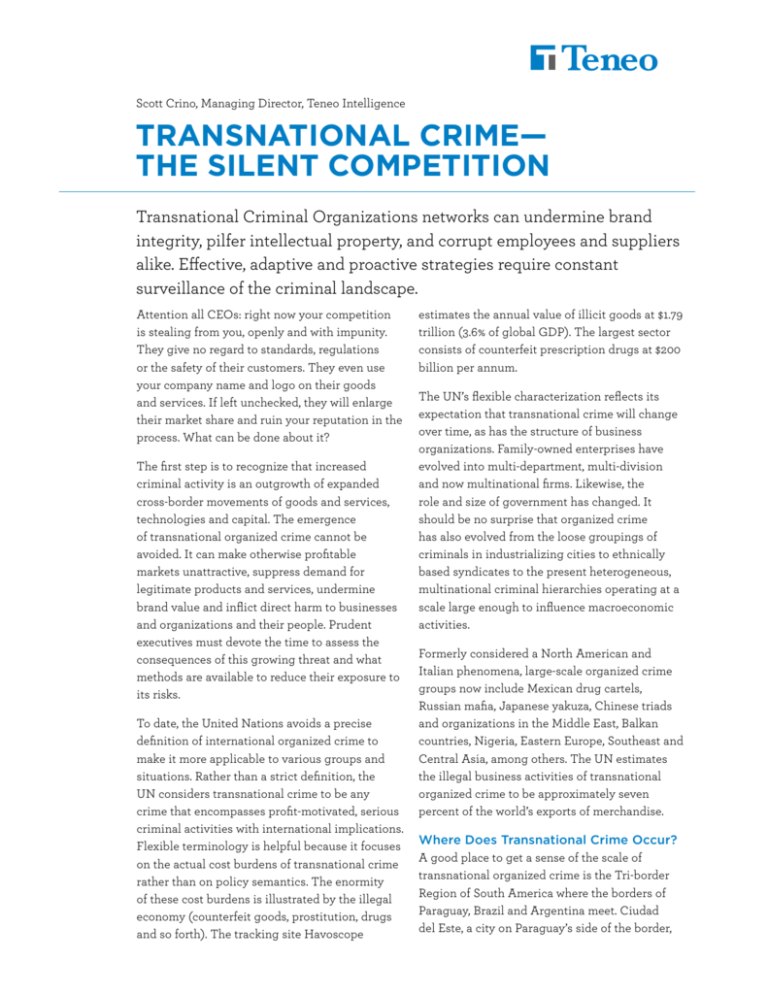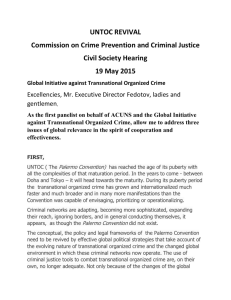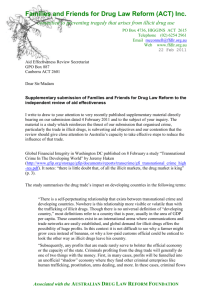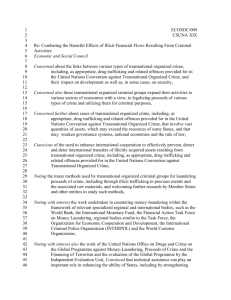transnational crime— the silent competition
advertisement

Scott Crino, Managing Director, Teneo Intelligence Transnational Crime— The Silent Competition Intelligence Strategy SM SM Transnational Criminal Organizations networks can undermine brand integrity, pilfer intellectual property, and corrupt employees Capital and suppliers alike. Effective, adaptive and proactive strategies require constant surveillance of the criminal landscape. SM Attention all CEOs: right now your competition is stealing from you, openly and with impunity. They give no regard to standards, regulations or the safety of their customers. They even use your company name and logo on their goods and services. If left unchecked, they will enlarge their market share and ruin your reputation in the process. What can be done about it? The first step is to recognize that increased criminal activity is an outgrowth of expanded cross-border movements of goods and services, technologies and capital. The emergence of transnational organized crime cannot be avoided. It can make otherwise profitable markets unattractive, suppress demand for legitimate products and services, undermine brand value and inflict direct harm to businesses and organizations and their people. Prudent executives must devote the time to assess the consequences of this growing threat and what methods are available to reduce their exposure to its risks. To date, the United Nations avoids a precise definition of international organized crime to make it more applicable to various groups and situations. Rather than a strict definition, the UN considers transnational crime to be any crime that encompasses profit-motivated, serious criminal activities with international implications. Flexible terminology is helpful because it focuses on the actual cost burdens of transnational crime rather than on policy semantics. The enormity of these cost burdens is illustrated by the illegal economy (counterfeit goods, prostitution, drugs and so forth). The tracking site Havoscope Restructuring estimates the annual value of illicit goods at $1.79 trillion (3.6% of global GDP). The largest sector consists of counterfeit prescription drugs at $200 billion per annum. The UN’s flexible characterization reflects its expectation that transnational crime will change over time, as has the structure of business organizations. Family-owned enterprises have evolved into multi-department, multi-division and now multinational firms. Likewise, the role and size of government has changed. It should be no surprise that organized crime has also evolved from the loose groupings of criminals in industrializing cities to ethnically based syndicates to the present heterogeneous, multinational criminal hierarchies operating at a scale large enough to influence macroeconomic activities. Formerly considered a North American and Italian phenomena, large-scale organized crime groups now include Mexican drug cartels, Russian mafia, Japanese yakuza, Chinese triads and organizations in the Middle East, Balkan countries, Nigeria, Eastern Europe, Southeast and Central Asia, among others. The UN estimates the illegal business activities of transnational organized crime to be approximately seven percent of the world’s exports of merchandise. Where Does Transnational Crime Occur? A good place to get a sense of the scale of transnational organized crime is the Tri-border Region of South America where the borders of Paraguay, Brazil and Argentina meet. Ciudad del Este, a city on Paraguay’s side of the border, SM I N S I G H T S : T r a nsn a ti o n a l C r i m e contains a small, nine by nine block free trade zone (FTZ) that is a bustling center of commerce compared to the rest of the country. While Paraguay is a landlocked, agriculturally-based and economically weak country, business booms in Ciudad del Este, the world’s third largest taxfree market zone after Hong Kong and Miami. Each day sees thousands of cargo trucks and tens of thousands of individuals carrying bags cross the narrow Friendship Bridge that connects Ciudad del Este with Brazil, overwhelming Brazilian customs authorities. Through this narrow chokepoint all manner of illicit goods pass heading from North America and Asia to Brazil. These goods account for twelve billion dollars in revenue to Ciudad del Este business enterprises each year. Narcotics, counterfeit goods and technologies, laundered monies and smuggled stolen automobiles all cross the bridge for purchase by Brazilian consumers in lieu of legitimate goods and services. From a national security perspective, the Triborder region raises concerns because of the connections some criminal enterprises there have with terrorist organizations, especially Middle Eastern terror groups. And whereas the U.S. State Department has not published any credible information showing that groups like Hezbollah and HAMAS use the Tri-border Area for terrorist training or other operational activity, it is speculated that these groups use the region to raise funds from local supporters. Underscoring this risk was the 2013 arrest in Ciudad del Este of Wassim Abd Fassel, a Paraguayan citizen and suspected member of Hezbollah, on human trafficking, money laundering and narcotics trafficking charges. Fadel was accused by Paraguayan police of depositing the proceeds from his illegal activities into Hezbollah linked bank accounts in Syria and Turkey. Unfortunately, Ciudad del Este is not unique as there are other evident examples of the nexus between transnational crime and terror across the globe. Take the Sahel Region of West Africa, which is home to a one billion dollar illicit Intelligence SM cigarette industry largely controlled by Mokhtar Belmokhtar, who was often referred to as Mr. Marlboro for his involvement in the cigarette trade. Now Belmokhtar is better known as a leading figure of Al Qaeda in the Islamic Maghreb. His Signed in Blood Brigade was responsible for the January 2013 terror attack on the Amenas gas facility in Southern Algeria where thirty-nine hostages died. Following later terror attacks by Belmokhtar, the U.S. announced a five million dollar reward for information leading to finding his death or capture. Strategy Capital 2 SM SM Restructuring The illicit business lines run by transnational criminal organizations are imaginatively diverse. They include a booming pasta trade run by crime syndicates that crosses the border to Mali from Algeria where wheat is subsidized and the government prevents its export. There is Russia, where 40 percent of the aluminum industry is reported to be controlled by organized crime, or Mexico where fifty percent of the oil and gas trade is infiltrated. And in China weak regulation of pharmaceutical manufacturing and distribution is thought to result in one third of Africa’s malarial medicine being fake or substandard. Among the contributing factors leading to the success and expansion of transnational organized crime are poor governance, economic disadvantage, persistent conflict and unmet needs. These conditions are exploited by Transnational Criminal Organizations (TCO) whose motives vary from profit to excitement to ideological and spiritual outlooks. Risks to Consumers Unlike crimes such as rape, murder and robbery, organized crime is often “victimless” and is underreported. There are many reasons for this. First, many TCO products and services are demand driven by the consumers. Cigarettes, gambling, drugs and everyday items like Algerian pasta are all in high demand by a customer base that is willing to take risks to acquire goods or services that are not legally available or at a significantly lower price point. Second, crime organizations offer jobs where employment SM I N S I G H T S : T r a nsn a ti o n a l C r i m e Intelligence and education opportunities are low. This is particularly true in developing countries where transnational crime is rampant, legislation is weak and the ability to prosecute large international crime rings is poor. Third, TCOs often give back to the community through infrastructure development and community services in an effort to gain and maintain loyalty from the local populace. Finally, many TCO activities go unreported for fear of retribution. Violence, or the credible threat of violence, is an intimidating and influential tool of the trade. Unfortunately, unreported crimes may never be investigated. Complicit and corrupt local and national law enforcement services have little incentive and lack the tools to pursue international trafficking organizations. Local entities are often hesitant to share sensitive information with their cross border counterparts. Additionally, globalization continues to outpace mechanisms to enforce global governance. Vast use of the Internet makes illicit commerce difficult to track; people and goods move more cheaply and quickly than ever before; and the intensity of commercial flows make it difficult to easily distinguish the licit from the illicit. The impact that transnational crime has on commercial, legitimate business cannot be understated, but the impact that is has on society is even greater. TCOs have no incentive to abide by national and international manufacturing standards. They have no reputation to protect, and fear of retribution by law enforcement is low. Counterfeit prescription drugs pose the greatest risk to consumers. As described by the United Nations Office on Drugs and Crime, “in addition to hastening the death to the many who go untreated, [counterfeit drugs] also can contribute to the generation of drug-resistant strains of the most deadly pathogens.” Safety concerns go well beyond counterfeit medications. From toys to auto parts, the risks posed to consumers are innumerable, indistinguishable and present in common, everyday items. The environment is SM 3 at risk as well. The exploitation and smuggling of natural resources by use of dangerous and environmentally unsustainable harvesting techniques drive entire ecosystems to the brink of extinction. Strategy Capital SM What Can be Done? Corporate executives face many challenges with transnational crime but they are not insurmountable. Lessening the potential impact of transnational crime starts with practicing robust oversight, conducting rigorous vulnerability assessments and following through with effective management controls against identified risks. Risk mitigation actions must be innovative, flexible and sustainable with strategies aimed toward dismantling the entire network, not just crime bosses and their affiliates, but also corrupt facilitators whether they are in the business community, government officials or political leaders. SM Restructuring Corporations should consider using the Whole of Government (WoG) approach used by the U.S. government as a paradigm for their anti-transnational crime policy. By using a WoG approach or other wide field of view methodologies, leaders can more readily understand the nature of threats they face but also gain a better appreciation for supplemental assets from outside the organization. A good place to start is by establishing an internal business intelligence capability to monitor and analyze relevant criminal activities in the market space. Effective, adaptive and proactive strategies require constant surveillance of the criminal landscape to include information sharing with industry peers and partnering with consultants, legal counsel and business intelligence professionals who possess the appropriate depth of experience in the region and business areas of concern. Partnership with a diverse array of NonGovernment Organizations, such as World Bank, World Health Organization, United Nations Office on Drugs and Crime (UNODC) SM I N S I G H T S : T r a nsn a ti o n a l C r i m e Intelligence and Interpol should also be considered when assessing corporate strategy. A proficient WoG approach considers all the resources available to address complex problems integrating diplomatic, communications, security, economics, finance, intelligence and law enforcement assets toward the common objective of protecting an organization’s assets and activities. With transnational crime, not all threats carry the same potential impact. Each should be considered in terms of their significance, likelihood and immediacy. Businesses also need to make selfdeterminations on their ability to adequately assess threats or whether they need an outside hand. A useful approach for drawing inferences from data and intelligence is through a collection of techniques known as Red Team analytics. Best led by unbiased facilitators, Red Teaming includes tabletop exercises, expert crowd-sourcing, gap analysis and other analytical processes that enable senior executives and management to draw inferences from information and intelligence which can guide decisions related to strategy, resource allocation, priorities and timing. Through Red Team events, executives can connect the people in their organization who best know their core competencies with outside experts who contextually understand new environments, understand the elements of power in play, and can exercise proposed strategies before commitments are necessary. The two examples that follow help give a sense of how transnational crime can negatively impact business operations and compel costly responses by companies. Example A. From 2007 to 2011 the number of pirate attacks off the coast of Somalia went from 30 to 275, an 850 percent increase. Suddenly, in 2012 pirate attacks dropped by 80 percent and as of June 2013, no ships had been successfully boarded in 12 months. The International Maritime Organization (IMO), the United Nations specialized agency with responsibility for the SM safety and security of shipping, coordinated anti-piracy patrols employing assets from several international navies, but their efforts were costly and the response to attempted attacks was slow. Ultimately, it was a commercially employed tactic that had the greatest effect in warding off pirates. In 2012, maritime shipping companies began using professionally trained, armed security on board ships while transiting dangerous waters, an action that was previously considered taboo in commercial shipping. Once security personnel were employed, pirate attacks fell off almost immediately. Strategy Capital 4 SM SM Restructuring Example B. Two unrelated but serious incidents were linked to counterfeit Apple iPhone chargers in China in July 2013: one resulted in a death and the other caused a life-threatening coma. In the first incident, a flight attendant was killed by electric shock after she reportedly answered a call on her iPhone 5, which may have been charging via a third party device. In the same week, another incident left a 30-year old man in a coma after he received an electric shock while connecting his iPhone 4 to a third-party adapter. In response to the alleged accidents, Apple Stores and retailers are selling for a limited time new, authentic chargers for just ten dollars with the turn in of an old or third-party device, less than half the retail price. This action is widely referred to as a public relations success that will improve Apple’s reputation with consumers and may even improve revenue. These examples represent the use of direct and indirect action. The direct action being armed security against sea pirates; the indirect being a marketing plan tied to public relations to address a consumer safety concern. The security operations against the sea pirates achieved the desired effect and Apple’s charger promotion seems a solid approach. There were, however, undoubtedly other options available but not taken. When considering transnational crime, executives can use methods like the Red Team activities as a way to assess and analyze the potential challenges SM I N S I G H T S : T r a nsn a ti o n a l C r i m e Intelligence which lie ahead and determine their organization’s capacity to develop a winning strategy to overcome disruptors. As long as transnational organized crime can continue to operate with impunity, TCOs will gain a larger share of the global economy. The increasing trend in transnational crime, coupled with largely ineffective international law enforcement, requires more commercial industries to step up and take action. Corporations must SM 5 remain vigilant, adaptive to criminal tactics and be willing to employ mitigation techniques through improved technologies and systematic processes that include a Whole of Government approach and strategic partnerships. Strategy M O R E I N F O R M AT I O N info@teneoholdings.com +1 (212) 886-1600 www.teneoholdings.com Capital SM SM Restructuring SCOTT CRINO Prior to joining Teneo, Dr. Crino spent 21 years as a US Army officer serving as an attack helicopter pilot (1991-1998) and operations research analyst (1998-2012). Upon his retirement from the armed services, he launched Crino Consulting Group where he currently serves as President. For the past several years, Dr. Crino has focused on the identification and analysis of emerging global threats and sources of instability relating to transnational crime and terror organizations. To date he has led numerous studies and co-authored and edited eight strategic-level analyses and several professional publications for the Department of Defense used to inform campaign planning and the strategic operations of US Departments of Defense, State and Homeland Security regarding threats to US national security across North, Central and South America, Europe, Africa and Asia. Dr. Crino’s previous military assignments include Operations Research Analyst and Troop Commander for the Asymmetric Warfare Group, Fort Meade, MD; Assistant Professor in the Department of Systems Engineering at the United States Military Academy, West Point, NY; Operations Research Analyst at the Training and Doctrine Command Analysis Center, Monterey, CA; and several command and staff positions in the Army Aviation branch. Additionally, he has served in many military theaters, including, Iraq, Afghanistan, Somalia and Haiti. Dr. Crino holds a PhD in Systems Engineering from the University of Virginia, an MS in Industrial Engineering from Texas A&M University, and a BS in Industrial Engineering from the State University of New York at Buffalo. His specialties include risk analysis, decision making processes, data mining, optimization and statistical analysis SM







